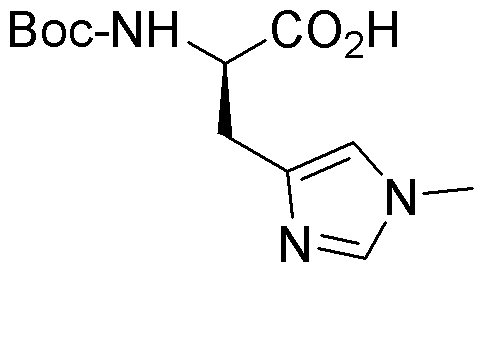Boc-D-His(1-Me)-OH is widely utilized in research focused on
- Peptide Synthesis: This compound serves as a key building block in the synthesis of peptides, particularly those that require histidine residues. Its protective Boc group allows for selective reactions, making it easier to construct complex peptide chains.
- Drug Development: In pharmaceutical research, Boc-D-His(1-Me)-OH is used to create drug candidates that target specific biological pathways. Its unique structure can enhance the efficacy of therapeutic agents, particularly in oncology and immunology.
- Bioconjugation: This chemical is employed in bioconjugation processes, where it helps attach biomolecules to surfaces or other molecules. This is particularly useful in developing targeted drug delivery systems and diagnostic tools.
- Protein Engineering: Researchers use Boc-D-His(1-Me)-OH to modify proteins, improving their stability and functionality. This application is crucial in creating enzymes with enhanced activity or specificity for industrial processes.
- Research in Molecular Biology: The compound is valuable in studying protein interactions and functions due to its ability to mimic natural amino acids. This helps scientists understand complex biological systems and develop new therapeutic strategies.
General Information
Properties
Safety and Regulations
Applications
Boc-D-His(1-Me)-OH is widely utilized in research focused on
- Peptide Synthesis: This compound serves as a key building block in the synthesis of peptides, particularly those that require histidine residues. Its protective Boc group allows for selective reactions, making it easier to construct complex peptide chains.
- Drug Development: In pharmaceutical research, Boc-D-His(1-Me)-OH is used to create drug candidates that target specific biological pathways. Its unique structure can enhance the efficacy of therapeutic agents, particularly in oncology and immunology.
- Bioconjugation: This chemical is employed in bioconjugation processes, where it helps attach biomolecules to surfaces or other molecules. This is particularly useful in developing targeted drug delivery systems and diagnostic tools.
- Protein Engineering: Researchers use Boc-D-His(1-Me)-OH to modify proteins, improving their stability and functionality. This application is crucial in creating enzymes with enhanced activity or specificity for industrial processes.
- Research in Molecular Biology: The compound is valuable in studying protein interactions and functions due to its ability to mimic natural amino acids. This helps scientists understand complex biological systems and develop new therapeutic strategies.
Documents
Safety Data Sheets (SDS)
The SDS provides comprehensive safety information on handling, storage, and disposal of the product.
Product Specification (PS)
The PS provides a comprehensive breakdown of the product’s properties, including chemical composition, physical state, purity, and storage requirements. It also details acceptable quality ranges and the product's intended applications.
Certificates of Analysis (COA)
Search for Certificates of Analysis (COA) by entering the products Lot Number. Lot and Batch Numbers can be found on a product’s label following the words ‘Lot’ or ‘Batch’.
*Catalog Number
*Lot Number
Certificates Of Origin (COO)
This COO confirms the country where the product was manufactured, and also details the materials and components used in it and whether it is derived from natural, synthetic, or other specific sources. This certificate may be required for customs, trade, and regulatory compliance.
*Catalog Number
*Lot Number
Safety Data Sheets (SDS)
The SDS provides comprehensive safety information on handling, storage, and disposal of the product.
DownloadProduct Specification (PS)
The PS provides a comprehensive breakdown of the product’s properties, including chemical composition, physical state, purity, and storage requirements. It also details acceptable quality ranges and the product's intended applications.
DownloadCertificates of Analysis (COA)
Search for Certificates of Analysis (COA) by entering the products Lot Number. Lot and Batch Numbers can be found on a product’s label following the words ‘Lot’ or ‘Batch’.
*Catalog Number
*Lot Number
Certificates Of Origin (COO)
This COO confirms the country where the product was manufactured, and also details the materials and components used in it and whether it is derived from natural, synthetic, or other specific sources. This certificate may be required for customs, trade, and regulatory compliance.


